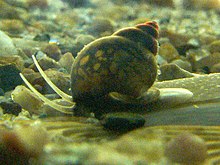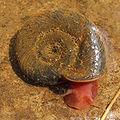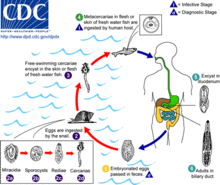
Oncomelania is a genus of very small tropical freshwater snails, aquatic gastropod mollusks in the family Pomatiopsidae.

Biomphalaria is a genus of air-breathing freshwater snails, aquatic pulmonates belonging to the family Planorbidae, the ram's horn snails and their allies.
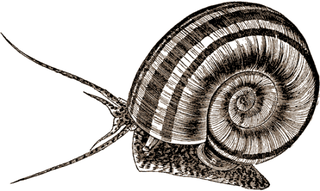
Marisa cornuarietis, common name the Colombian ramshorn apple snail, is a species of large freshwater snail with an operculum, an aquatic gastropod mollusc in the family Ampullariidae, the apple snail family.

Basommatophora was a term that was previously used as a taxonomic informal group, a group of snails within the informal group Pulmonata, the air-breathing slugs and snails. According to the taxonomy of the Gastropoda, whenever monophyly has not been tested, or where a traditional taxon of gastropods has now been discovered to be paraphyletic or polyphyletic, the term "group" or "informal group" was used.
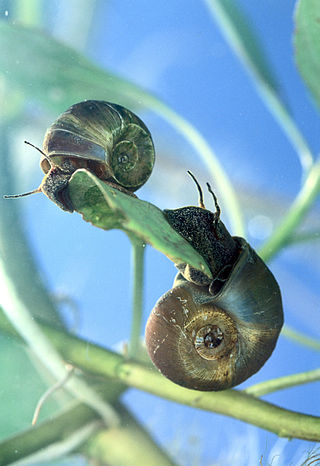
Planorbella trivolvis is a species of freshwater air-breathing snail, an aquatic pulmonate gastropod mollusk in the family Planorbidae, the ram's horn snails, or planorbids, which all have sinistral or left-coiling shells.

Physidae, commonly called the bladder snails, is a family of small air-breathing freshwater snails, aquatic pulmonate gastropod molluscs in the superfamily Lymnaeoidea.

Pleuroceridae, common name pleurocerids, is a family of small to medium-sized freshwater snails, aquatic gilled gastropod mollusks in the superfamily Cerithioidea.These snails have an operculum and typically a robust high-spired shell.

Pomatiopsidae is a family of small, mainly freshwater snails, that have gills and an operculum, aquatic gastropod mollusks in the superfamily Truncatelloidea.

Clithon retropictum(Korean: 기수갈고둥,Japanese: 石蜑螺) is a species of freshwater and brackish water snail with an operculum, a nerite. It is an aquatic gastropod mollusk in the family Neritidae, the nerites.

Hygrophila is a taxonomic superorder of air-breathing freshwater snails, aquatic pulmonate gastropod mollusks within the clade Panpulmonata.

Biomphalaria tenagophila is a species of air-breathing freshwater snail, an aquatic pulmonate gastropod mollusk in the family Planorbidae, the ram's horn snails.
Biomphalaria andecola is a species of air-breathing freshwater snail, an aquatic pulmonate gastropod mollusk in the family Planorbidae, the ram's horn snails.
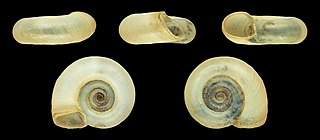
Biomphalaria peregrina is a species of air-breathing freshwater snail, an aquatic pulmonate gastropod mollusk in the family Planorbidae, the ram's horn snails.

Indoplanorbis is a genus of air-breathing freshwater snail. Its only member species is Indoplanorbis exustus, an aquatic pulmonate gastropod mollusk in the family Planorbidae, the ram's horn snails. The species is widely distributed across the tropics. It serves as an important intermediate host for several trematode parasites. The invasive nature and ecological tolerance of Indoplanorbis exustus add to its importance in veterinary and medical science.
Radix luteola is a species of freshwater snail, an aquatic gastropod mollusc in the family Lymnaeidae.

Lymnaeoidea, commonly known as pond snails, is a taxonomic superfamily of air-breathing freshwater snails that belong to the superorder Hygrophila.
